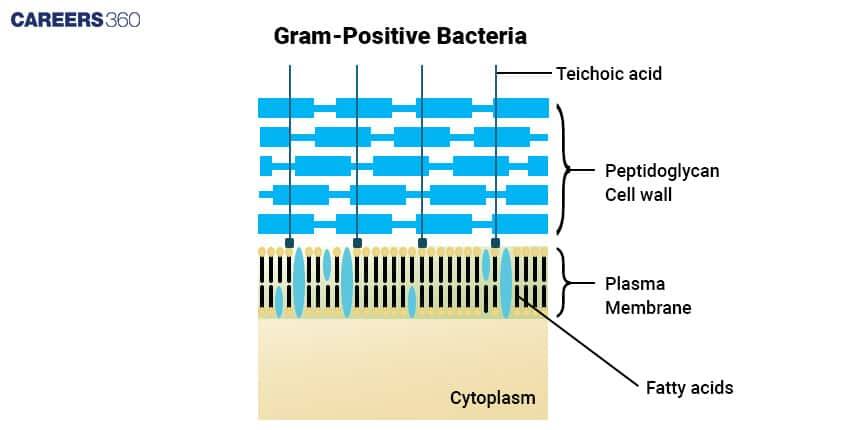Composition of Bacterial Cell Wall: Overview, Topics, Structure
The bacterial cell wall is made up of peptidoglycan, a complex molecule of sugars and amino acids. The composition of the bacterial cell wall varies between bacteria, with gram-positive bacteria having a thick peptidoglycan layer, while gram-negative bacteria have a thinner layer and an outer membrane. The bacterial cell wall structure is essential for maintaining cell shape and protecting the cell. A bacterial cell wall diagram typically shows the differences between gram-positive and gram-negative bacteria. This is an important topic of biology as it links some of the major chapters.
This Story also Contains
- Composition of Bacterial Cell Wall
- Gram-Positive Bacterial Cell Wall
- Gram-Negative Bacterial Cell Wall
- Defective Bacterial Cell Walls
.jpg)
The bacterial cell wall is a firm, protective layer outside the cell wall, essential for maintaining the bacterium's shape and providing defence against environmental stress. The composition of the bacterial cell wall is primarily made up of peptidoglycan, a polymer that provides strength to the structure. Gram-positive bacteria have a thick peptidoglycan layer and teichoic acids, while gram-negative bacteria feature a thinner peptidoglycan layer, an outer membrane, and lipopolysaccharides that contribute to antibiotic resistance.
Composition of Bacterial Cell Wall
The peptidoglycan, a mesh-like polymer of the bacterial cell wall, provides important rigidity and strength. Teichoic acids are found in Gram-positive bacteria and provide structural stability and function to the cell wall. Lipopolysaccharides are found in the outer membrane of Gram-negative bacteria and are very important in protection from environmental threats and antibiotics.
Also Read:
Gram-Positive Bacterial Cell Wall
The bacterial cell wall of gram-positive bacteria is made up of a thick, multilayered peptidoglycan layer, which may constitute up to 90% of the composition of the bacterial cell wall. This extensive peptidoglycan layer provides strength and rigidity to the cell, protecting it against osmotic pressure and mechanical stress. Some of the basics are discussed below:
- Gram-positive bacterial cell walls consist of a thick, multilayer peptidoglycan coat, as much as 90% of the cell wall.
- The structural rigidity and strength for the cell are provided by the thick peptidoglycan layer, shielding the cell against osmotic pressure and mechanical stress.
- Teichoic acids are embedded in the cell wall and have significant functions in wall stability, ion homeostasis, and bacterial virulence.
- The peptidoglycan and teichoic acids combination guarantees stability and survival of Gram-positive bacteria.
- The structure is crucial for bacterial survival and is usually represented in bacterial cell wall diagrams for simplicity.
A diagram of the Gram-positive bacterial cell wall

Gram-Negative Bacterial Cell Wall
The Gram-negative bacterial cell wall is made up of a thin layer of peptidoglycan, which is sandwiched between an inner cytoplasmic membrane and an outer membrane. This outer membrane contains high quantities of lipopolysaccharides, which contribute significantly to the structural integrity of the Gram-negative cell wall and act as a barrier against unwanted access, including that of antibiotics. Some of the basics are discussed below:
- Gram-negative bacterial cell walls consist of a thin peptidoglycan layer positioned between the inner cytoplasmic membrane and the outer membrane.
- The outer membrane is lipopolysaccharide (LPS) rich, adding extra structural strength and serving as a barrier against toxic substances such as antibiotics.
- The structure confers more resistance to environmental stress and antimicrobial agents than Gram-positive bacteria.
- The composition of the Gram-negative cell wall makes the bacteria stronger and more resistant to hostile conditions.
- The components of the cell wall peptidoglycan, lipopolysaccharides, and other molecules collaborate to stabilise and protect the bacterial cell.
Defective Bacterial Cell Walls
The bacterial cell wall is required for shape maintenance, rigidity, and osmotic stress protection. Nevertheless, under some environmental or chemical challenges, like the presence of antibiotics (e.g., penicillin), lysozymes, or bacteriophage infection, the bacterial cell wall integrity can be disrupted. The disruption results in cell wall-deficient structures, which are temporary (L-forms) or permanent (as in Mycoplasma). These adaptations allow bacteria to thrive in extreme environments and be resistant to antimicrobial agents by altering or dropping their cell walls. Some basic points are discussed below:
- L-forms are transient, cell wall-deficient bacterial forms provoked by stress, particularly antibiotics, and are capable of reverting to their normal form.
- Mycoplasma is a naturally occurring cell wall-deficient bacterial genus and is inherently resistant to beta-lactam antibiotics.
- Spheroplasts are incomplete cell wall-deficient forms usually derived from Gram-negative bacteria and are usually non-viable.
- Protoplasts are full-wall-deficient forms derived from Gram-positive bacteria and are usually viable and can be regenerated.
- Bacterial wall deficiency is a reflection of adaptive survival under antimicrobial or environmental stress.
Other useful Resources:
Frequently Asked Questions (FAQs)
This provides the bacterial cell wall with rigidity and structural support that protects the cell from osmotic pressure and helps in the shape maintenance of the cell.
Gram-negative bacteria have an outer membrane barrier that prevents many antibiotics from reaching their target sites within the cell wall or membrane.
Bacterial adhesion, colonisation, and evasion of host immune responses are facilitated by a component such as lipopolysaccharides and teichoic acids, thereby enhancing the ability to cause disease.
Gram-positive bacteria contain thick peptidoglycan and teichoic acids, while Gram-negative bacteria have thin peptidoglycan sandwiched between an inner and outer membrane; most of the latter contain lipopolysaccharides.
These penicillins are acting on the transpeptidase enzyme, which normally cross-links the peptidoglycan strands. These ultimately result in the weakening of the cell wall, and the foremost consequence is the lysis of bacterial cells.